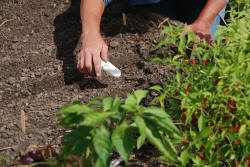|
 Maximize
Your Harvest with Succession Planting Maximize
Your Harvest with Succession Planting
By Melinda Myers
[June 21, 2025]
Make the most of every square inch of garden space
and containers with succession planting. As you harvest your first
crop of the season, consider replanting the space with a vegetable
that will mature and can be harvested before the end of the growing
season.
Start by calculating the number of frost-free days remaining in your
growing season. Next review the plant tags and seed packets for the
number of days from planting to harvest. Compare these two to see if
you have time to replant one or maybe even two more quick-maturing
vegetables in that space.
|
Keep in mind that cool season crops like lettuce,
spinach and radishes perform and taste best when grown and harvested
during the cooler months of spring and fall. Consider using these
quick-maturing vegetables as your last planting of the season.
Others, like broccoli, collards and kale, taste even better after a
light frost. Planting these so they mature in fall is another way to
extend the harvest for maximum flavor and nutrition.
Warm season vegetables, like beans and cucumbers, are perfect for a
summer planting. They prefer warm air and soil for the best growth
and productivity.
Here are a few vegetables you may want to include in your succession
planting this summer. Leaf lettuce and spinach prefer cooler
temperatures and depending on the variety are ready to harvest in 30
to 60 days. If you can’t wait for cooler weather, try growing more
heat-tolerant greens, like Sandy and Red Sails lettuce, and although
they are not true spinaches New Zealand and Malabar are more heat
tolerant and provide a similar flavor.

End the season with a harvest of peas. Short varieties, like Patio
Pride and Sugar Ann sugar snap peas and Maestro and Laxton’s
Progress #9 shelling peas, are perfect for containers and small
spaces.
Root crops make great additions to succession plantings. Salad
radishes are ready to harvest in 25 to 30 days, beets in 50 to 60
days, and carrots in 60 to 70 days.
Bush beans prefer warm temperatures and are ready to begin picking
in 50 to 80 days. Mascotte compact snap beans are productive compact
plants perfect for containers and window boxes. You’ll start
harvesting these in as few as 50 days.
Cucumbers and summer squash are another option for summer plantings.
Vining varieties can be trained onto a support to save space or
crawl over the ground. Bush types are perfect for containers and
small spaces. Check the seed packet for the number of days from
planting to harvest.
[to top of second column]
|

Increase the health and productivity of your second
planting by preparing the soil before planting seeds and
transplants. Mix an inch of quality compost into the top six inches
of soil. You’ll improve drainage in heavy soil, increase water
retention in fast-draining sandy soils, and add micronutrients that
feed the soil, building microorganisms.
Once your seeds and transplants are in the ground, be sure to water
properly. Keep the seedbed and roots of transplants moist the first
few weeks. Gradually reduce watering frequency as seedlings sprout
and grow and transplants become established.
You may need to adjust your succession planting schedule based on
the weather. Hotter and cooler than normal temperatures can delay
seed germination, harvest times, and flavor.
With a bit of planning, succession plantings, and regular harvesting
you can enjoy fresh vegetables throughout the growing season.
Melinda Myers has written more than 20 gardening books,
including the Midwest Gardener’s Handbook, 2nd Edition and Small
Space Gardening. She hosts The Great Courses “How to Grow Anything”
instant video and DVD series and the nationally syndicated Melinda’s
Garden Moment TV & radio program. Myers is a columnist and
contributing editor for Birds & Blooms magazine and was commissioned
by Summit for her expertise to write this article. Myers’ website is www.MelindaMyers.com.
[Photo courtesy of MelindaMyers.com]
 |